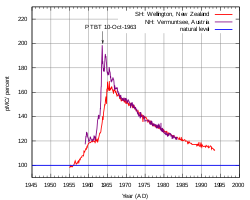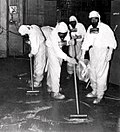Radioactive contamination




Radioactive contamination or radiological contamination is the contamination of the environment with radioactive materials, where these materials are not present. Many radioactive substances have very long half lives; this means that if they are present in the envioroment, they can be dangerous for a very long time. Many nuclear power plants produce such substances; usually they are processed to radioactive waste. There is little danger that comes from radioactive waste,if it is stored safely.
Causes
- Incidents in nuclear power plants
- Nuclear medicine uses radiation for the treatment of illnesses. Sometimes, there are accidents.
- Explosions in nuclear facilities (and atomic bombs) cause nuclear fallouts: This means that nuclear particles are scattered using normal atmospheric phenomena, such as the weather
- Nuclear reprocessing can contaminate water
Accidents
Radioactive Contamination Media
Bomb pulse: the global airborne contamination by atmospheric nuclear weapon tests almost doubled the concentration of 14C in the Northern Hemisphere. Plot of atmospheric 14C, New Zealand and Austria. The New Zealand curve is representative for the Southern Hemisphere, the Austrian curve is representative for the Northern Hemisphere. .
A clean-up crew working to remove radioactive contamination after the Three Mile Island accident.
References
- ↑ Richard Schiffman (12 March 2013). "Two years on, America hasn't learned lessons of Fukushima nuclear disaster". The Guardian.
- ↑ Martin Fackler (June 1, 2011). "Report Finds Japan Underestimated Tsunami Danger". New York Times.
- ↑ Togzhan Kassenova (28 September 2009). "The lasting toll of Semipalatinsk's nuclear testing". Bulletin of the Atomic Scientists.
- ↑ 4.0 4.1 Goldfarb, Alex; Litvinenko, Marina (2007). Death of a Dissident: The Poisoning of Alexander Litvinenko and the Return of the KGB. Simon & Schuster UK. ISBN 978-1-4711-0301-8.
- ↑ Johnston, Wm. Robert. "K-19 submarine reactor accident, 1961". Database of radiological incidents and related events. Johnston's Archive. Retrieved 24 May 2012.
- ↑ Johnston, Wm. Robert. "K-27 submarine reactor accident, 1968". Database of radiological incidents and related events. Johnston's Archive. Retrieved 24 May 2012.
- ↑ Johnston, Wm. Robert. "K-431 submarine reactor accident, 1985". Database of radiological incidents and related events. Johnston's Archive. Retrieved 24 May 2012.
- ↑ "Lost Iridium-192 Source".
- ↑ The Radiological Accident in Goiania p. 2.
- ↑ Strengthening the Safety of Radiation Sources Archived 2009-03-26 at the Wayback Machine p. 15.
- ↑ Gusev, Igor; Guskova, Angelina; Mettler, Fred A. (12 December 2010). Medical Management of Radiation Accidents, Second Edition. CRC Press. pp. 299–303. ISBN 978-1-4200-3719-7.
- ↑ 12.0 12.1 Bagla, Pallava (7 May 2010). "Radiation Accident a 'Wake-Up Call' For India's Scientific Community". Science. 328 (5979): 679. Bibcode:2010Sci...328..679B. doi:10.1126/science.328.5979.679-a. PMID 20448162.
- ↑ International Atomic Energy Agency. "Investigation of an accidental Exposure of radiotherapy patients in Panama" (PDF).
- ↑ Johnston, Robert (September 23, 2007). "Deadliest radiation accidents and other events causing radiation casualties". Database of Radiological Incidents and Related Events.
- ↑ Patterson AJ (2007). "Ushering in the era of nuclear terrorism". Critical Care Medicine. 35 (3): 953–4. doi:10.1097/01.CCM.0000257229.97208.76. PMID 17421087.
- ↑ Acton JM, Rogers MB, Zimmerman PD; Brooke Rogers; Zimmerman (September 2007). "Beyond the Dirty Bomb: Re-thinking Radiological Terror". Survival. 49 (3): 151–168. doi:10.1080/00396330701564760. S2CID 154617638.
{{cite journal}}: CS1 maint: multiple names: authors list (link) - ↑ Sixsmith, Martin (2007). The Litvinenko File: The Life and Death of a Russian Spy. True Crime. p. 14. ISBN 978-0-312-37668-0.
- ↑ Bremer Mærli, Morten. "Radiological Terrorism: "Soft Killers"". Bellona Foundation. Archived from the original on 2007-12-17. Retrieved 2014-11-15.





